The Museum Collections
Introduction
I. History and Art Collection
1. Icons of the 14th – 19th centuries
icons of the 14th – 17th century
2. Jewelry art of the 14th – 20th century
jewelry art of the 14th – 17th century
jewelry art of the 18th – 19th century
the european silver 14th - 19th centuries
3. Small-size sculptures (works of metal, wood, bone)
XI – the beginning of the XX century
Small-size sculptures 11th – 17th century
Small-size sculptures 18th – early 20th century
enamel of Troitza masters 15-8th – early 20th century
5.Embroidery, lace, textiles of the 14th - early 20th century
icon and ornamental embroidery
gold and silver lace
6.Painting of the 18th – 21st centuries
painting of the 18th – 19th centuris
painting of the 20th – 21st centuris
II.Manuscripts and old printed books of the 14th – 17th century
IV.Lithography of the 18th – 19th century
V.Numismatics
VI.Medals of the 18th - early 20th century
VIII.Archeology collection
IX. Russian folk and applied and decorative art of the 17th – 21st c.
1. Artistic wood
folk carved and painted wood
wooden toys
house carving of Sergiev Posad
Khokhloma and Gorodets painting
2. Artistic textiles
embroidery and weaving
printed textiles and lace
Russian shawls
folk costumes
folk garments
printed cotton kerchiefs
|
The gold-silver lace of the 17th – the beginning of the 20th centuries (p. 1) |
The gold-silver lace along with pearl and gold sewing, embroidery and weaving actively have used in an ornament of subjects of a secular life and a church cult throughout several centuries. The collection of the gold-silver lace of the Sergiev-Posad museum totals about 150 units of storage. Into this collection enters samples of a measured lace and subjects of a church cult. In ¬ which decorative furniture along with gold and pearl sewing the considerable role has played the lace, tatting from gold and silver threads. The part of the collection makes endowments to Trinity-St.Sergius monastery.
A gold-silver lace has appeared for the first time in Russia in second half of the 16th century. As it has noted above, this original kind of arts and crafts has come to us from the Western Europe. On all extent of the 17th and in first half of the 18th centuries the lace was imported into Russia in considerable quantities, and not only finished articles, but also high-quality gold and silver threads, which were used by skilled workers in sewing and lace network. The love to gold-silver lace and its wide circulation in Russia, especially in the 17th century, explains first that it on the decorative qualities perfectly was in harmony with big-patterned the heavy fabrics, occurring at that time, with free breed of clothes and with magnificent pearl and gold the sewing, which has reached of blossoming in the 17th century. By the gold-silver lace have richly decorated imperial, seigniorial, princely clothes, a dress of noble family, a vestments of clergy, various subjects of secular and church use, and in 18th century it actively gets and into a national life.
About that, how much wide a gold-silver lace has applied in church everyday life, convincingly testify Inventories of Trinity St.Sergius monastery of the 17th- beginning of the 20th centuries. Therefore, in earliest of remained monastic Inventories of 1641 15 works with a lace, including vestry’s four covers, have appeared. In the Inventory of 1735 it is mentioned about 30 products with a lace, in the Inventory of 1756 - more than 50 etc.
Seigniorial or princely front rooms, and female monasteries, in which talented workers of skill, could be the centers of the lace-network. Earliest works of gold-silver lace in museum meeting concern second half - to the end of the17th century. Motives of a carnation and a tulip - typical for all Russian design and West European art was the favorite in gold-silver lace-network of the 17th centuries. These motives were most typical for a lace of Flemish type. The lace with carnation and tulip images makes one of the basic groups of patterns in museum collection.
|

Chasuble. The gold-silver lace on the hem. The end of the 17th century. Has enclosed in the Trinity-St.Sergius monastery in 1699 by boyar A.S.Sheyn |
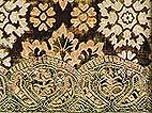
Waistcloth (fragment). The ornament of the silver edge. The third quarter of the 17th century |
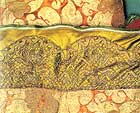
Chasuble (fragment). The gold-silver lacy edge. The end of the 17th century. Has enclosed in the Trinity-St.Sergius monastery in 1700 by boyar A.S.Sheyn. |
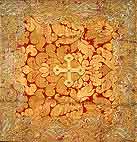
Small cover for Eucharist (fragment). The gold-silver edge. The end of the 17th century
|
In the museum’s collection, samples of the lace of the 18th century are most full presented. About the centers ¬of the gold-silver lace-network that time we, unfortunately, have no concrete data. It is possible, that in this craft continued to be engaged in imperial workshops, female monasteries and merchant families.
In the 18th century in connection with distribution of the European suit, the gold-silver lace starts to disappear gradually from a life of noble family, and in the second half of that century was completely superseded by the very fashionable in Europe thin cotton lace. However, during same time the gold-silver lace has widely used in an ornament of subjects of church use. Motives of a carnation and a tulip continue to meet and in lacy since the 18th century, but are treated more plane and boring, as on presented chasuble from crimson brocade with a large silvery flower pattern.
In the beginning of the 18th century, various compositions of Russian “agramant” have arise and developed. Plant-geometrical ornaments were most typical for “agramant” in the first half of 18th century. Such ornamental elements as «vilyushka», a teeth-scallops, "grid", fanlike motives have received the further development in cotton lace-network of the 18th – 19th centuries.
|
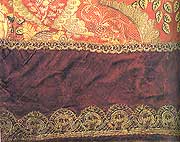
Chasuble (fragment). The silvery lace. 1st half of the 18th century |
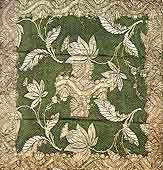
Air of the green brocade. The silver lace-agramant is along the edges sewn. The middle of the 18th century |
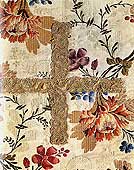
Veil (fragment). On the munnion is the cross from gold “agramant”. The middle of the 18th century (
|
Ðlane-geometrical ornaments of the second half - the end of the 18th century differ a limiting composite saturation, but at the same time - strict rhythm and clearness of construction. From middle of the 18th of a century in a gold-silver lace was began to add the colour thread (dark blue, red, green), that has considerably raised decorative effect. This reception is characteristic only for Russian metal lace-network with its aspiration to beauty. There is a so-called lace-grid. As, for example, “sulok” (double scarf on a top of the archimandrite staff) made from silver-gold grids with the monogram of metropolitan Platon. Along the edges of “sulok” there is a silvery fringe.
In the museum collection, the special group has made up the lace of the 18th century of the West European origin, that has received the name in Russia - «podishpany» from French «point d'Espagne». Costing very expensively, this lace was accessible only to representatives of exclusive estates, in which environment it used the big popularity. «Podishpany» are representing a lace-guipure executed from very thin gold-silver lace or spin threads in the coupling techniques. They intended, as a rule, for an ornament of female dresses and hats, man's camisoles.
In collection of the museum subjects of church¬ use are presented exclusively with furnish «podishpany». ¬ It decorates a veil of the red atlas with a pearl Golgotha cross and the ornamental border, enclosed in the Trinity-St.Sergius monastery in 1638 by council clerk I.T.Gramotin. The lace, sewn, possibly, in the first half of the 18th century, has not broken composite ¬ integrity of product. By the lace-guipure, it is sheathed also the small veil of the European sewing from the pink atlas.
|

“Sulock”. The silver-gilded grid. The end of the 18th century |
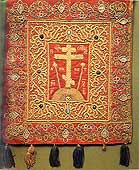
Veil «The Cross on Golgotha». The middle of the 17th century. The Lace. 1st half of the 18th century. The Western Europe |
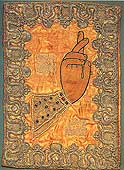
The small cover for Eucharist. Lace-guipure. The 18th century. The Western Europe
|
|


